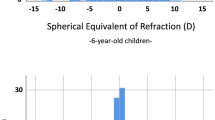Abstract
Atkinson has shown that early correction of hypermetropia reduces the incidence of esotropia. If esotropia is reduced by prescribing glasses early, the rate of esotropia-induced amblyopia can be similarly reduced; this would have important economic consequences. We have studied (1) how costs compare to benefits in early visual screening, (2) how videorefraction as used by Atkinson compares to retinoscopy, and (3) whether esotropia is more likely to occur in children who have increasing as opposed to decreasing hypermetropia. The costs of the study so far have been high. It was exceedingly difficult to get all infants invited, come to the clinic and examined. Videorefraction did not compare favourably with retinoscopy in terms of costs and precision, whereas the amount of skill and time needed was approximately equal. The third question, whether esotropia is more likely to occur in children who have increasing as opposed to decreasing hypermetropia, arose from the controversy whether, in the general population, refraction increases or decreases during the first years of life. We found that papers reporting a decrease of hypermetropia in early childhood were studies of large cross-sections of the general population, whereas papers that reported an initial increase originated from ophthalmological practices or strabismus departments. These conflicting results could be reconciled by assuming a population bias: if esotropia is more likely to occur in children with increasing hypermetropia, children with increasing hypermetropia will preferentially be seen by ophthalmologists. It seems natural that children with increasing hypermetropia are more likely to squint, because additional accommodation, needed to overcome increasing hypermetropia, will inevitably confer additional convergence. This relationship has meanwhile been confirmed by others.
Similar content being viewed by others
References
Atkinson J, Braddick O, Wattam-Bell J, Durden K, Bobier W, Pointer J. Photorefractive screening of infants and effects of refractive correction. Invest Ophthalmol 1987; 28 (ARVO suppl): 399.
Tommila V, Tarkkanen A. Incidence of loss of vision in the healthy eye in amblyopia. Br J Ophthalmol 1981; 65: 575–77.
Wang Yu-dong Br J Ophthalmol 1990; 74: 650–53.
Brown EVL. Net average yearly changes in refraction of atropinized eyes from birth to beyond middle life. Arch Ophthalmol 1938; 19: 719.
Brown EVL. Use-abuse theory of changes in refraction versus biologic theory. Arch Ophthalmol 1942; 28: 845–50.
Slapater FJ. Age norms of refraction and vision. Arch Ophthalmol 1950; 43: 466–81.
Lahav-Guss C, Kaufmann H. Refraktionsänderungen im Kindesalter: Hyperopie. Klin Mbl Augenheilk 1974; 164: 274–78.
Lepard CW. Comparative changes in the error of refraction between fixing and amblyopic eyes during growth and development. Am J Ophthalmol 1975; 80: 485–90.
Herrnheiser J. Die Refraktionsentwicklung des menschlichen Auges. Z Heilk 1892; 13: 342–77.
Molnár L. Refraktionsuntersuchungen. Acta Med Acad Sci Hung 1967; 23: 297–308.
Aurell E, Norrsell K. A longitudinal study of children with a family history of strabismus: factors determining the incidence of strabismus. Br J Ophthalmol 1990; 74: 589–94.
Abrahamsson M, Fabian G, Sjöstrand J. Longitudinal changes in refraction and riskindicators for amblyopia. Invest Ophthalmol 1991; 32 (ARVO suppl): 1238.
Author information
Authors and Affiliations
Rights and permissions
About this article
Cite this article
Simonsz, H.J., Grosklauser, B. & Leuppi, S. Costs and methods of preventive visual screening and the relation between esotropia and increasing hypermetropia. Doc Ophthalmol 82, 81–87 (1992). https://doi.org/10.1007/BF00156997
Accepted:
Issue Date:
DOI: https://doi.org/10.1007/BF00156997




